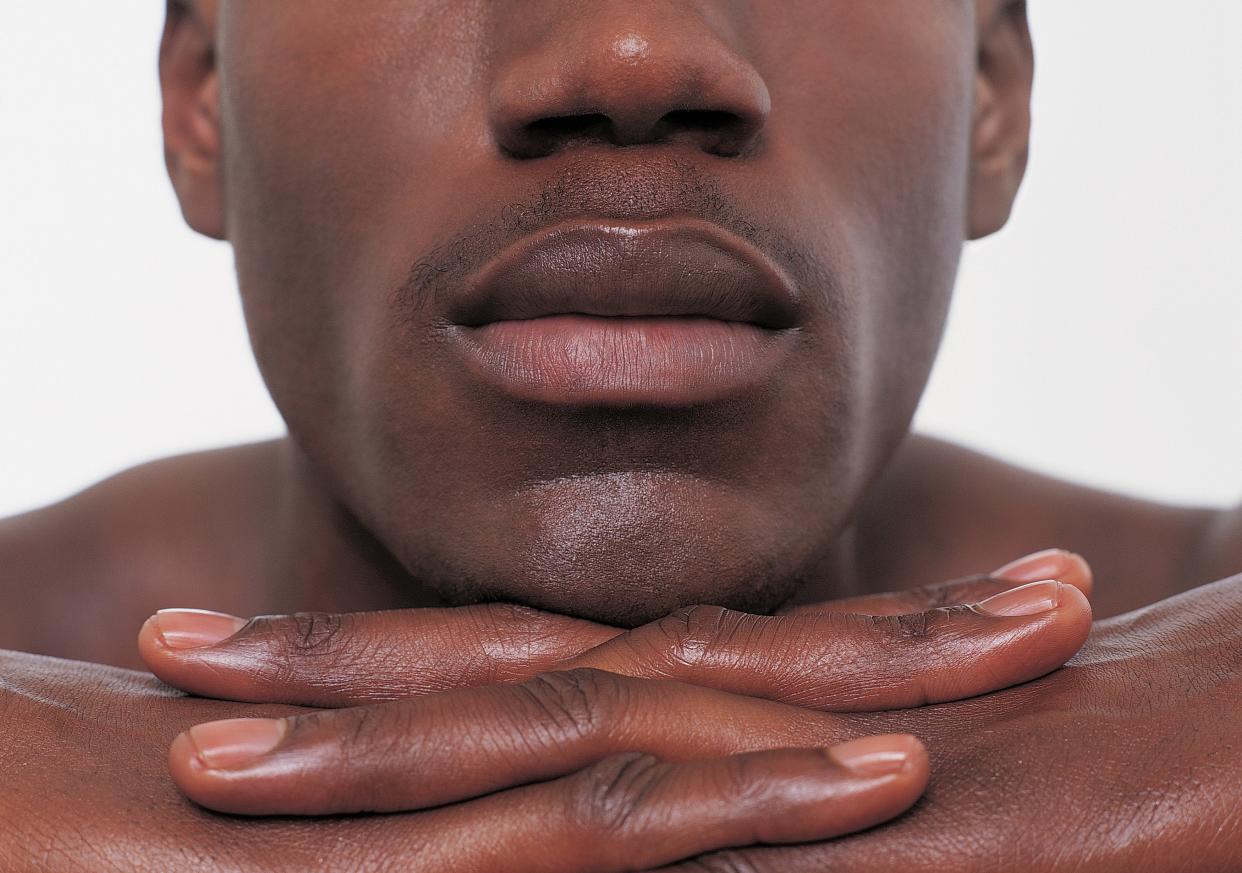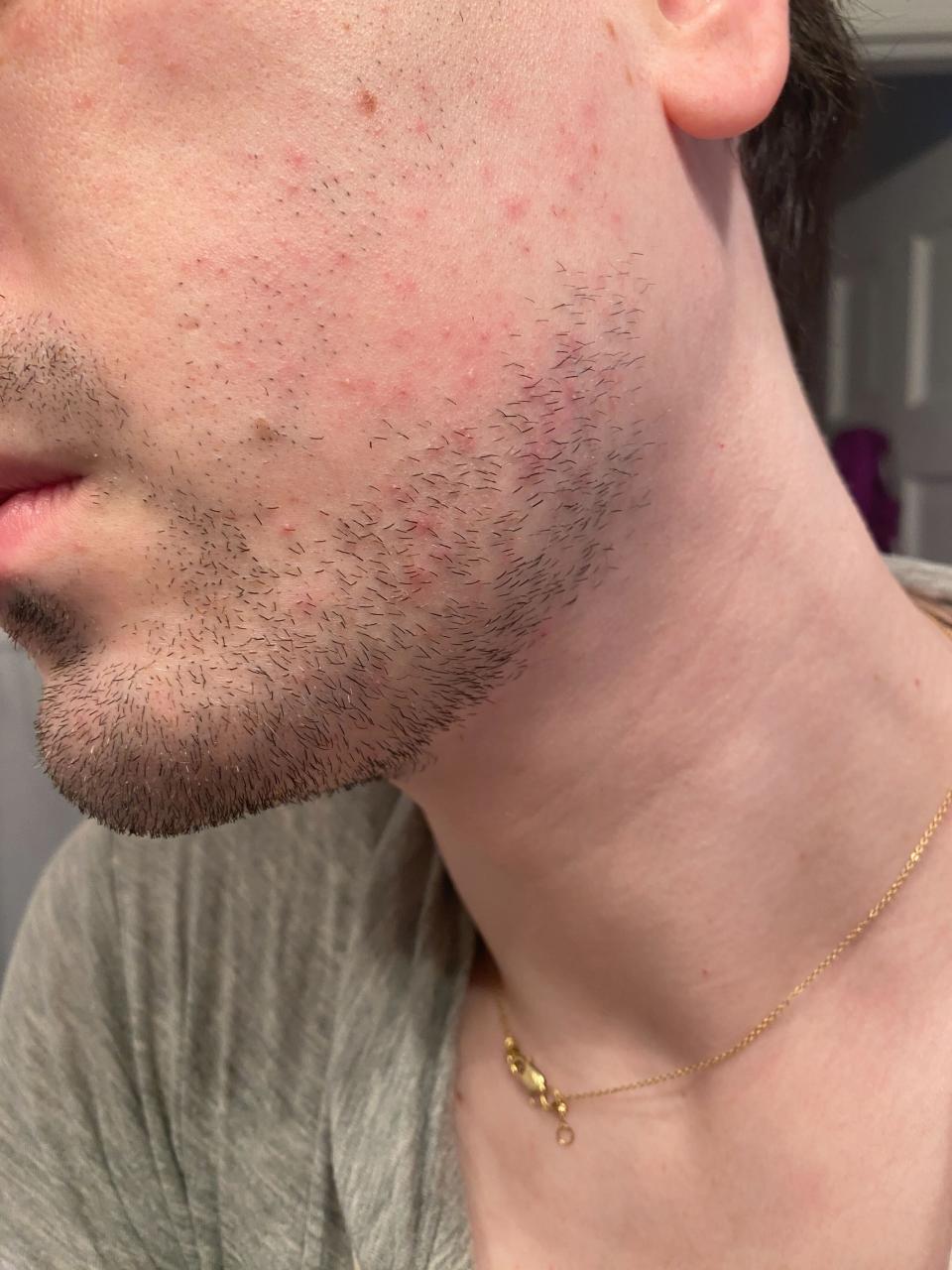The Complete Guide to Laser Facial Hair Removal

Getty Images
I was a plucky 12-year-old when I first asked my dad to teach me to shave my face. An old soul—the kind of kid who begged for my apple juice to be served in a wine glass—and finally standing at the threshold of puberty meant I was one step closer to driving and watching MTV’s The Real World unsupervised. Little did I know that this gleefully anticipated milestone would become a burdensome chore, one that would be synonymous with discomfort, irritation, and a litany of skin concerns.
Up until my mid-twenties, I was predominately taking care of peach fuzz. As I aged, however, my unwanted facial hair became uber-thick, absurdly dark, and coarse. Some hairs on my face are so coarse, in fact, that they could be used as war tools for a small army of ants. I learned to shave with trepidation and a prayer, hoping to stave off my enemy: folliculitis, a variation of ingrown hairs often called “razor bumps,” that can result in post-inflammatory hyperpigmentation (PIP), among other things. In my case, folliculitis manifested as many, many pesky inflamed patches dappled with blemishes.
I tried every trick of the trade: single-use razors, safety razors, razors with soothing strips, gel shaving creams, foaming shaving creams, face wash in lieu of shaving cream, astringent aftershaves, steaming my face—and more, if you can believe it. By 28-years-old, I was one breakout away from toning my face with holy water to exorcize my recurring folliculitis. But first, I decided to try one final means to achieve the smooth skin and dolphin-like hairlessness I so desired: laser hair removal.

While most commonly thought about for the legs, bikini line, and armpits, laser hair removal is an often-prescribed treatment for conditions all over the body—including the face. “People often associate laser hair removal with just reduction in hair for cosmetic purposes, but oftentimes there's actually a medical purpose behind the procedure,” says Mona Gohara, MD, a board-certified dermatologist in Hamden, Connecticut, citing hidradenitis suppurativa, a chronic condition that manifests as nodules and sores in friction-prone areas that can result in scarring, along with hyperpigmentation and folliculitis. “I see the trickle-down effect of how all of these things can affect people. And, honestly, by removing the hair follicles in those areas, many times you're going to notice a significant improvement in the medical condition.”
Emboldened by my conversations with peers and my disdain for facial hair, I embarked on my laser hair removal journey under the supervision of New York City-based board-certified dermatologist Dendy Engelman, MD.
Meet the experts:
Mona Gohara, MD, is a board-certified dermatologist in Hamden, Connecticut.
Dendy Engelman, MD, is a board-certified dermatologist in New York City.
Michelle Henry, MD, is a board-certified dermatologist in New York City.
How does laser hair removal work?
Lasers use heat energy to target the melanin—the pigment that gives hair, skin, and eyes color—at the base of follicles. “The laser heats the melanin enough that it damages or destroys the follicle such that it can’t grow as effectively, or stops growing completely,” says Michelle Henry, MD, a board-certified dermatologist in New York City. This is why darker hair is easier to remove than lighter hair—there’s more melanin to target. It’s also why removing hair from deeper skin tones is more difficult: some lasers can't distinguish between dark hair and dark skin. Dr. Henry stresses the importance of selecting the right laser for each patient’s skin tone and hair color: “We choose a laser that delivers enough thermal energy to destroy the targeted follicle without harming the skin.”
I have dark, almost-black facial hair and skin so fair I could be a body double for Casper the Friendly Ghost. Dr. Engelman said I am what is often considered the ideal candidate for laser: The discrepancy between my fair skin and dark hair makes it much easier for a laser to locate and destroy the melanin in the hair follicle, as opposed to melanin in the epidermis above it, which can be a challenge for anyone inexperienced in administering lasers.
Dr. Engelman selected the Splendor X brand laser for my treatment. “[It’s] dual frequency, meaning two different wavelengths of light,” she tells me. “One is an Nd:YAG, which is 1064 nanometers, typically used for deeper skin tones. The other one is an Alexandrite laser, which is 755 nanometers.” For more melanated skin, the Alexandrite is often avoided in favor of the Nd:YAG to avoid hyper or hypopigmentation. The latter heats melanin at the root of the follicle more gently, meaning the likelihood of damaging melanin in the skin is greatly reduced.
“For you, I use both wavelengths to increase efficacy as I’m not worried about hyper or hypopigmentation in your skin type,” Dr. Engelman says. “This allows me to set the fluence, or parameters, fairly high in order to target the hair pigment without worrying that I will adversely affect your skin pigment.”
If this sounds granular and complicated, that’s because it is—and for good reason. Considering these details is paramount to avoid major complications—and the reason it’s best to visit a board-certified dermatologist versus a medspa. "The fact that you can go to a nail salon and there's a [laser] in the back does not mean that you should be treated there," says Dr. Engelman. The risk are burning and scars is especially high if you have dark skin.
But skin tone isn’t a dealbreaker when considering candidacy for laser hair removal treatments. “Being black or brown should not preclude you from getting a hair removal laser,” Dr. Gohara says. “You just have to be cognizant and research that the person who is handling the laser is a board-certified dermatologist who has experience in [treating different skin tones].” Dr. Engelman corroborates this sentiment, noting that hair color—not skin tone—is the most critical factor. “We still haven't tricked the code enough to be able to figure out how to laser away white peach fuzz on people's faces because there's no target for the laser to hit,” she says. “The target is the melanin pigment that's at the base of the follicle and that's why darker hair is easier to remove than white hair.”
Can laser facial hair removal help with skin concerns?
Common issues laser hair removal can treat include the aforementioned folliculitis and hidradenitis suppurativa. “I do a lot of male necks where they're getting folliculitis or what's called pseudofolliculitis barbae, which is where the hairs are curled and they in-grow and cause skin irritation,” Dr. Engelman says. “Most people who suffer with folliculitis in that area, it'll come and go, but it's never fully gone.”
And, as Dr. Gohara says, there is a deeply emotional connection between a lack of facial hair and self-esteem. “There are much deeper implications in terms of self-confidence and self-determination when it comes to these procedures that can make a big difference for people,” she says.
This is particularly true of patients seeking gender-affirming care; chiefly, treating conditions like hirsutism from polycystic ovary syndrome (something that can, in many cases, fracture one’s relationship with their femininity), and as a gender dysphoria-alleviating treatment for those transitioning. "If you're taking estrogen to transition from being a male to a female, you may need more laser hair removal treatments, because it is hormones that are induced, not biologically produced," Dr. Gohara says. "It is a different scenario and does need to be handled with empathy and patience and understanding."
How much does laser facial hair removal cost?
While I received my own treatment gratis with the understanding I’d be sharing my experience with you, dear reader, the cost of the service varies wildly and can depend on geographic location and the number of treatments required for the individual’s desired result. That said, Dr. Gohara estimates the average price per session on the face can range from $200 to $600. However, it’s important to remember this is a multi-staged process that requires at least four treatments to notice results. And for most patients, one or two touchup treatments a year are needed to stave off stubborn hairs and target any regrowth (more on this in a moment).
Does laser facial hair removal hurt?
During our first treatment, Dr. Engelman warned me that laser hair removal is particularly painful on the head and neck, especially for those, often men, who have coarser hair. Discomfort is affected by a laundry list of factors, though; pain tolerance being the most obvious. However, the ubiquitous “it just feels like a rubber band’s snap!” is—for me—a sinister and egregious lie. If the fabled rubber band was dipped in napalm, I could perhaps agree, but the sensation sits closer to pain than mild discomfort. (As a cosmetic procedure veteran, I know my pain tolerance is up to snuff.) The chin and upper lip are, in my experience, a particularly hellish, eye-watering area. “The denser the hairs are, the more heat you’re going to experience because you have more melanin to target,” says Dr. Henry.

Thankfully, though, lasers have come a long way since they first hit the market, with their speed and efficiency improving exponentially. Since their genesis, the width of the laser emission, or spot size, has also increased. “Our spot size is 20 millimeters by 20 millimeters,” says Dr. Engelman. (That’s about the size of a dime.) “A lot of them used to be five by five and it took an hour to do someone’s back.” So, yes, it hurt, but my entire face takes less than five minutes for which I thank the forefathers of laser medicine.
How should you care for your skin after laser facial hair removal?
The greatest challenge following a laser hair removal appointment is the urge to tug at the dead hairs, still attached to the follicle but lying limp and ripe for the plucking. I find myself standing at my vanity, inspecting my skin, tempted like Odysseus resisting the sirens’ song. Dr. Engelman says it’s best to let nature take its course. By two weeks, the hairs targeted by the laser will dislodge from the follicle naturally.
For the most part, post-care treatment is simple. “Immediately afterward, we don't want you to use vitamin A and retinols and anything that could be harsh,” says Dr. Engelman. “And avoid the sun. Your melanocytes have been stimulated by UV radiation, so the risk of hyper or hypopigmentation is higher.”
How do you keep up laser facial hair removal?
No matter which laser your doctor selects for your skin tone, the great equalizer for anyone getting laser hair removal on their face is the treatment cadence. Expect to go in for treatments every four weeks, which syncs with the body’s natural hair growth cycle: the antigen phase, meaning growing; the catagen phase, which is when the hair rests; and the telogen phase, the period when the hair falls out.
“We can only actively treat hairs in the antigen or growth cycle,” Dr. Engelman says. “You can't kill something that's already fallen out. That's why we don't want you to wax the hair beforehand or tweeze or pluck it, because then there's no hair. There’s no target for the laser to hit.” (Shaving in advance—preferably the night before—is fine, and even recommended to avoid potential irritation.)
For most patients, four to six treatments may result in a 70 to 80 percent reduction in overall hair growth, with many only needing annual touch-up for stubborn hairs (every six months for some people; more like two years for others). Of course, this varies based on the person and touchups can be necessary anywhere from every six months to every few years, according to Dr. Gohara.
Six months and six treatments under my belt, I gawk at the smoothness of the skin along my jawline and cheeks. No sores, or redness. With a few swipes of an electric razor every three days, I can now eliminate every hair on my face. I’m free of the blemishes and the hairs trapped in inflamed, beet-red mounds—mounds that were rarely larger than a sesame seed, but would weigh so heavily on my self-esteem. Honestly, more heavily than I even realized, until a few five-minute appointments liberated me from the tenderness and frustration of folliculitis—and the drawerful of razors, balms, and salves that I have now gleefully replaced with... well, different beauty products. (Hey, it's part of the job!) Full-coverage concealers and foundations have exited stage right, replaced by skin tints and a newfound confidence.
Read more about laser treatments:
The Complete Guide to Laser Resurfacing Treatments for Your Skin
How to Take Care of Your Skin After an In-Office Laser Treatment
Watch the history of hair removal:
Follow Allure on Instagram and TikTok, or subscribe to our newsletter to stay up to date on all things beauty.
Originally Appeared on Allure


